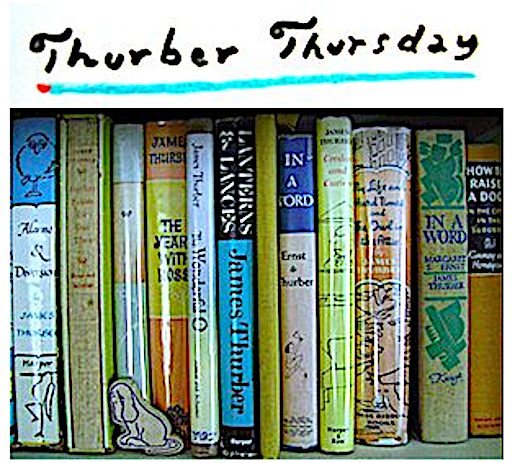“…Blame The Unconscious, I Guess”
As mentioned a few Thurber Thursdays ago, I’ve been once again re-visiting Harrison Kinney’s massive James Thurber: His Life And Times.
I happened upon this passage yesterday that I could easily identify with [it’s on page 421]. Thurber is speaking (in an interview with Kinney) about how his famous “house that merges into the head of a woman” came about:
“I never know how those things turn out as they do, so we may as well blame the unconscious, I guess.The better ones come like that, when I just start drawing lines, not knowing where I’m going, until finally I have something and then think up a caption to go with it.”
I’m one of those folks who run away from “process” discussions. I don’t know where ideas come from, and I don’t want to know. I love the idea of it all being a mystery. The ideas — the ones that work that is — that show up on the 8 1/2″ x 11″ piece of paper in front of me are like a surprise party.
I read an interview with a cartoonist the other day where someone identified as an “idea generator” was mentioned a few times. I immediately thought of a conveyor belt. I wince at the thought of any kind of organized assembly of cartoons. But that’s me. As the late great New Yorker cartoonist, Jack Ziegler once said to me when we were discussing various methods of beginning the work day: “Whatever works.”
__________________________________________________________________
James Thurber’s A-Z Entry:

James Thurber Born, Columbus, Ohio, December 8, 1894. Died 1961, New York City. New Yorker work: 1927 -1961, with several pieces run posthumously. According to the New Yorker’s legendary editor, William Shawn, “In the early days, a small company of writers, artists, and editors — E.B. White, James Thurber, Peter Arno, and Katharine White among them — did more to make the magazine what it is than can be measured.”
Key cartoon collection: The Seal in the Bedroom and Other Predicaments (Harper & Bros., 1932). Key anthology (writings & drawings): The Thurber Carnival (Harper & Row, 1945). There have been a number of Thurber biographies. Burton Bernstein’s Thurber (Dodd, Mead, 1975) and Harrison Kinney’s James Thurber: His Life and Times (Henry Holt & Co., 1995) are essential. Website
Jack Ziegler’s A-Z Entry:


Jack Ziegler (photo above, by Michael Maslin, taken at The Museum of Comic and Cartoon Art, NYC, 2008) Born, Brooklyn, NY July 13, 1942. Died, March 29, 2017. New Yorker work: 1974 – 2017. Key collections: all of Ziegler’s collections are must-haves. Here’re some favorites: Hamburger Madness (Harcourt Brace Jovanovich, 1978), Filthy Little Things ( Doubleday/Dolphin, 1981) and The Essential Jack Ziegler, Complied and Edited by Lee Lorenz ( Workman, 2000). Link here for Ink Spill’s Jack Ziegler interview from late 2016.
Link here to the Jack Ziegler website.


